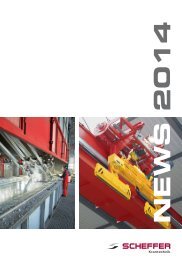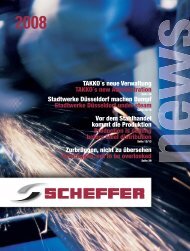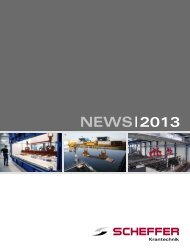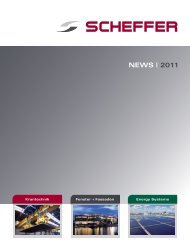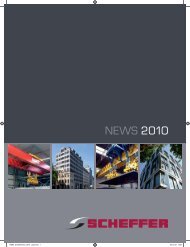12NEWS | 2012 - Scheffer Energy Systems
12NEWS | 2012 - Scheffer Energy Systems
12NEWS | 2012 - Scheffer Energy Systems
Sie wollen auch ein ePaper? Erhöhen Sie die Reichweite Ihrer Titel.
YUMPU macht aus Druck-PDFs automatisch weboptimierte ePaper, die Google liebt.
10 11<br />
Nummer 17<br />
Number 17<br />
Die Firma Alois Schmitt in Karlsruhe ist<br />
seit ihrem Neubau 1998 treuer <strong>Scheffer</strong>-<br />
Kunde. Auch bei der zuletzt realisierten<br />
Baumaßnahme, so dass mittlerweile<br />
insgesamt 17 Krane im Unternehmen<br />
das bekannte <strong>Scheffer</strong>-Logo tragen.<br />
Neben dem Umbau eines Bestandkranes<br />
mit neuester Magnethebetechnik<br />
wurde in einen zusätzlichen Kran, ebenfalls<br />
mit <strong>Scheffer</strong>-Magnethebetechnik,<br />
investiert. Da mit diesem Kran bzw.<br />
der Magnethebetechnik höher legierte<br />
Stähle (z. B. 42CrMo4) bewegt werden,<br />
ist hier die Entmagnetisierung des<br />
transportierten Materials notwendig,<br />
um den Restmagnetismus aus dem<br />
Material heraus zu bekommen.<br />
The Alois Schmitt company in Karlsruhe<br />
has been a loyal customer of <strong>Scheffer</strong>'s<br />
since the new building in 1998. This was<br />
also the case during the last building<br />
measures undertaken with the 17th crane<br />
in the company to bear the <strong>Scheffer</strong><br />
logo. In addition to the retrofitting of an<br />
existing crane with the latest magnet lifting<br />
technology an investment in another<br />
crane, which also featured magnet lifting<br />
technology, was made. As this crane or<br />
the magnetic lifting equipment is used to<br />
move steels with a higher alloy content<br />
(e. g. 42CrMo4), demagnetization of the<br />
transported material is necessary to<br />
ensure that the residual magnetism is<br />
removed from the material.<br />
www.eisen-schmitt.de<br />
Entmagnetisierung<br />
Ferromagnetische Materialien bestehen<br />
aus vielen kleinen Elementarmagneten,<br />
die sogenannten „Weißschen Bezirke“.<br />
Die Elementarmagnete sind im unmagnetisierten<br />
Zustand ungeordnet. Durch<br />
das Anlegen eines äußeren Magnetfeldes<br />
richten sich die Elementarmagnete<br />
in die gleiche Richtung aus. Der ferromagnetische<br />
Werkstoff wird selber zum Magneten.<br />
Dieser ungewollte Effekt führt zu<br />
Problemen bei der Weiterverarbeitung<br />
des Materials. Beispielhaft sei hier das<br />
Kleben von Spänen an spanend bearbeitetem<br />
Material oder der erhöhte Verschleiß<br />
an Sinterwerkzeugen genannt.<br />
Zur Vermeidung dieses Effektes bietet<br />
die <strong>Scheffer</strong>-Magnethebetechnik die<br />
Funktion des Entmagnetisierens. Mittels<br />
dieser Funktion wird das Material beim<br />
Ausschalten der Magnete einem starken<br />
magnetischen Wechselfeld (Wechsel der<br />
Polarität von + und –) ausgesetzt. Dieses<br />
Wechselfeld wird in seiner Stärke stetig<br />
bis auf null reduziert. Die homogene<br />
Ausrichtung der „Weißschen Bezirke“<br />
wird zerstört und die magnetische Wirkung<br />
auf unkritische Werte für nachgeschaltete<br />
Bearbeitungsgänge verringert.<br />
Demagnetization<br />
Ferromagnetic materials consist of many<br />
small molecular magnets, the so-called<br />
“Weißschen Bezirke”. The molecular<br />
magnets are disordered in the demagnetized<br />
state. By applying an external<br />
magnetic field, all the molecular magnets<br />
arrange themselves in the same direction.<br />
Ferromagnetic materials are themselves<br />
transformed to be magnets. This<br />
unintended effect causes problems when<br />
processing the material. For example, this<br />
can be the adhesion of swarf on material<br />
that is being machined or increased<br />
wear on sintered tools. <strong>Scheffer</strong> magnetic<br />
lifting equipment offers a demagnetization<br />
function to avoid this effect. Using<br />
this function, the material is subjected to<br />
a very strong alternating magnetic field<br />
(change of the polarity of + and –) when<br />
the magnets are being switched off. This<br />
alternating field is consistently reduced<br />
in its strength down to zero. The homogeneous<br />
alignment of the “Weißschen<br />
Bezirke” is destroyed and the magnetic<br />
effect is reduced to non-critical levels for<br />
subsequent machining stages.



